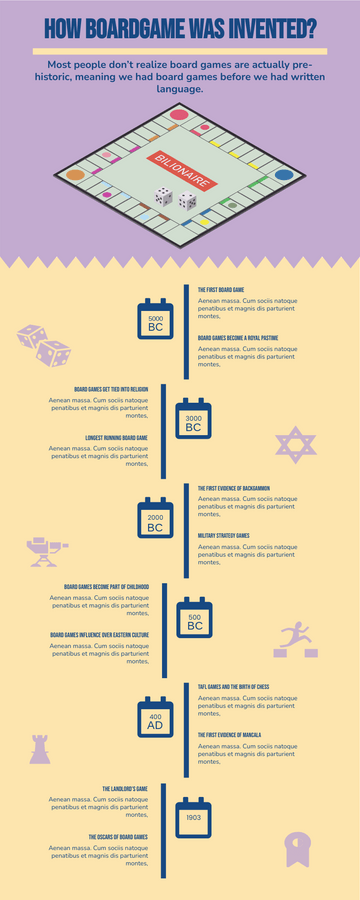Boardgame Infographic
Desktop games have traditionally been a subset of table games, including moving or placing pieces on pre-marked surfaces or “boards” according to a set of rules. Typically, desktop games do not have to contain physical desktops. Some games are based on pure strategy, but many contain elements of luck; Some are pure coincidences, without skill elements.
Games usually have a goal that the player need to achieve. Although early table games represented battles between the two armies, most modern table games were still based on defeating opponents to win positions, or accumulate points, for example:
Monopoly is one of the most popular board game which Hasbro is currently publishing. The game has several house rules, as well as several spin-offs and associated media, and hundreds of different editions exist. Having been licensed locally in more than 103 countries and printed in more than 37 languages, Monopoly has become a part of international popular culture. In the game:
- Players roll two six-sided dice to move, buy and sell properties, and build them with houses and hotels around the game board.
- Players earn rent from their competitors, with the intention of driving them into bankruptcy.
- Chance and Community Chest cards, and tax squares, money can also be won or lost;
- Players can end up in prison, from which they can not move until they have fulfilled one of many requirements.
- The game has several house rules, as well as several spin-offs and associated media, and hundreds of different editions exist.
- Having been licensed locally in more than 103 countries and printed in more than 37 languages, Monopoly has become a part of international popular culture.

The Top Five Facts of Monopoly Board Games
- The Monopoly game is based on Atlantic City, New Jersey.
- Charles Darrow first developed the Monopoly game in 1933 based on the Landlord’s Game (by Lizzie Magie in US).
- Charles Darrow is from Philadelphia.
- The original game was made from materials from Darrow’s own home. A piece of oilcloth covered the board and the cards were handwritten.
- The original houses and hotels were made from wooden molding scraps.

